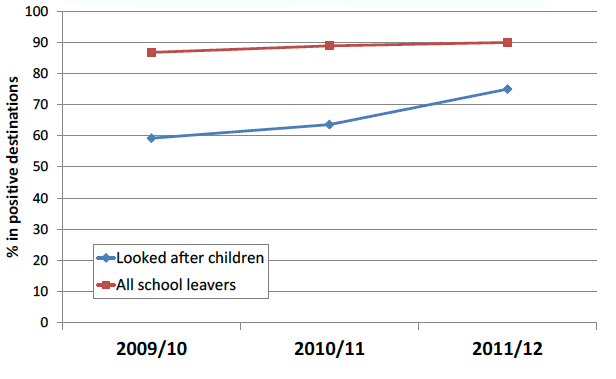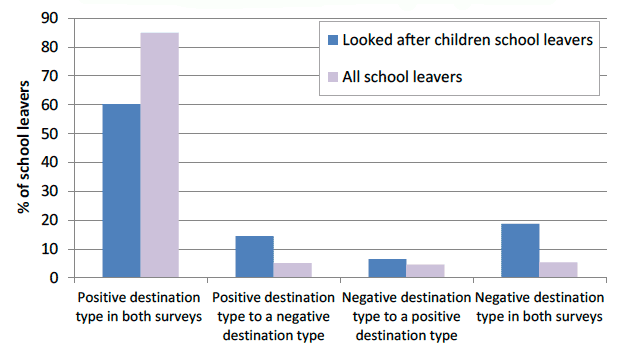Education outcomes for Scotland's looked after children, 2011/12
Leaver destinations and average tariff scores of Scotland's Looked after children who left school during the academic year 2011-12. Also includes analysis from a longitudinal dataset of looked after children between 2008-2012.
This document is part of a collection
Post-school destinations of looked after children

This section presents data on the initial and follow up destinations of looked after young people who left school during the academic year 2011/12.
Initial and follow-up destinations
Young people are followed up twice after leaving school to assess their initial destination (three months after they leave school) and their follow up destination (nine months after leaving school). A young person is said to be in a positive destination if they are in education, employment, training, voluntary work or an activity agreement.
For more information on school leaver destination categories, see background note 4.11.
Chart 2: Looked after children in postive destinations three months after leaving school, 2009/10 to 2011/12

As previously mentioned, the lower proportion of looked after children going into positive destinations is likely to be related to looked after young people leaving school at younger ages. However, while the proportion of looked after young people going into a positive destination post-school is still lower than for all school leavers, it is improving at a much faster rate so the gap is narrowing (Chart 2).
Three-quarters (75 per cent) of looked after children who left school during 2011/12 were in a positive destination at the time of the September initial destination survey, compared with nine in ten (90 per cent) of all 2011/12 school leavers (Table 2.1). This is an 11 percentage point increase for looked after children since 2010/11 compared to a one percentage point increase for all school leavers. Among looked after young people 5 per cent were in Higher Education three months after leaving school and two in five (41 per cent) were either in Higher or Further Education.
Table 2.1: Percentage of school leavers by initial destination, for all school leavers and those who were looked after children, 2009/10, 2010/11 and 2011/12(1)
Looked after children |
All school leavers |
|||||
|---|---|---|---|---|---|---|
2009/10 |
2010/11 |
2011/12 |
2009/10 |
2010/11 |
2011/12 |
|
Higher Education |
1 |
* |
5 |
36 |
36 |
37 |
Further Education |
33 |
31 |
36 |
27 |
27 |
27 |
Training |
18 |
15 |
15 |
5 |
6 |
5 |
Employment |
6 |
9 |
8 |
19 |
19 |
20 |
Voluntary Work |
1 |
* |
* |
0 |
0 |
0 |
Activity Agreement (2) |
- |
6 |
10 |
- |
1 |
1 |
Unemployed Seeking |
36 |
32 |
19 |
11 |
10 |
8 |
Unemployed Not Seeking |
5 |
* |
6 |
1 |
1 |
1 |
Unknown |
0 |
* |
1 |
1 |
0 |
0 |
% in a positive destination (3),(4) |
59 |
64 |
75 |
87 |
89 |
90 |
(1) Cells containing * represent small numbers that have been suppressed to maintain confidentiality
(2) Activity Agreements were introduced in 2010/11 and therefore are not included in 2009/10 figures.
(3) Positive destination includes higher education, further education, training, voluntary work, employment. From 2010/11 it also includes activity agreements, which affects the per cent in a positive destination between 2009/10 and 2010/11.
(4) Due to rounding some totals will not equal the sum of their parts.
Non-looked after children are more likely to maintain a positive destination nine months after leaving school than looked after children. By the time of the March follow-up destination survey, just over two thirds (67 per cent) of looked after children who left school during 2011/12 who were in a positive destination, compared with 89 per cent of all 2010/11 school leavers. The rate of positive destinations among looked after children at follow up survey has improved over the last three years - from 44 per cent in 2009/10 to 67 per cent in 2011/12 (Table 2.2).
Table 2.2: Percentage of school leavers by follow-up destination, for all school leavers and those who were looked after children, 2009/10, 2010/11 and 2011/12(1)
Looked after children |
All school leavers |
|||||
|---|---|---|---|---|---|---|
2009/10 |
2010/11 |
2011/12 |
2009/10 |
2010/11 |
2011/12 |
|
Higher Education |
1 |
2 |
4 |
34 |
34 |
36 |
Further Education |
25 |
22 |
29 |
25 |
25 |
25 |
Training |
12 |
14 |
13 |
3 |
3 |
4 |
Employment |
7 |
10 |
11 |
23 |
24 |
24 |
Voluntary Work |
1 |
0 |
0 |
1 |
1 |
- |
Activity Agreement (2) |
- |
7 |
9 |
- |
1 |
1 |
Unemployed Seeking |
47 |
36 |
24 |
12 |
10 |
8 |
Unemployed Not Seeking |
7 |
7 |
8 |
2 |
2 |
2 |
Unknown |
2 |
2 |
1 |
1 |
1 |
1 |
% in a positive destination (3) ,(4) |
44 |
55 |
67 |
85 |
87 |
89 |
Sustained destinations
Chart 3: Initial and follow-up destinations of looked after children and all school leavers, 2011/12

Looked after children are more likely to be in negative destinations (such as unemployment) in both the surveys than non-looked after children. One in five (19 per cent) of looked after school leavers were in a negative destination in both surveys in 2011/12 compared to one in twenty (5 per cent) of all school leavers. Looked after children are also less likely to be in a positive destination in both surveys. Only 60 per cent of looked after children who left school during 2011/12 were in a positive destination in both surveys, compared with 85 per cent for all school leavers (Chart 3, Table 2.3). The proportion of looked after children being in positive destinations in both surveys has increased by 14 percentage points since 2010/11. The gap in the proportion of school leavers maintaining positive destinations between looked after and non-looked after children has narrowed over the last three years, from 44 percentage points in 2009/10 to 25 percentage points in 2011/12.
The main difference in outcomes between looked after and non- looked after young people is in the proportion who start in a positive destination and move to a negative one - 18 per cent among looked after children who left school in 2011/12, compared to five per cent of all 2011/12 school leavers - and a much higher proportion of looked after children who were in a negative destination in both surveys. However the proportion of looked after children moving from a positive destination at the initial survey to a negative one at the follow up survey has decreased over the last three years, with it having fallen by 13 percentage points since 2009/10.
Table 2.3: Percentage of school leavers by sustained destination for all school leavers and those who are looked after children, 2011/12
Sustained Destination |
Looked after children |
All school leavers |
||||
|---|---|---|---|---|---|---|
2009/10 |
2010/11 |
2011/12 |
2009/10 |
2010/11 |
2011/12 |
|
Positive destination in both surveys |
35.8 |
45.9 |
60.2 |
80.0 |
82.6 |
84.9 |
Positive destination to negative destination |
23.5 |
17.8 |
14.5 |
6.9 |
6.3 |
5.1 |
Negative destination to a positive destination |
8.6 |
9.1 |
6.5 |
5.2 |
4.6 |
4.6 |
Negative destination in both surveys |
32.1 |
27.1 |
18.7 |
7.9 |
6.4 |
5.4 |
Cross-UK comparisons
The improvements seen in the proportion of looked after children in Scotland moving into positive destinations after leaving school over the last three years mirrors the general trend across the UK. Because of differences in the education systems between Scotland and the rest of the UK (and in the ages at which looked after children's qualifications are measured) it is not possible to directly compare qualification levels of looked after children. See background note 5.7 for further information.
Contact
Email: Kirsten Hilland
There is a problem
Thanks for your feedback